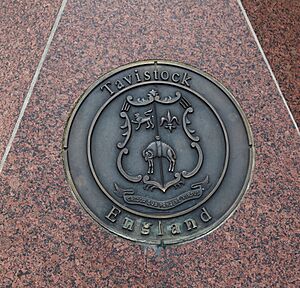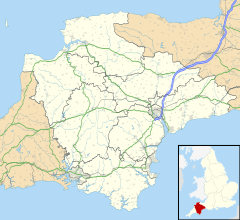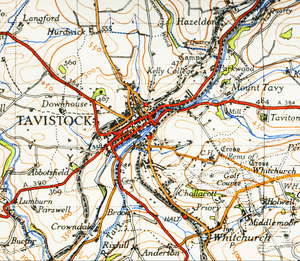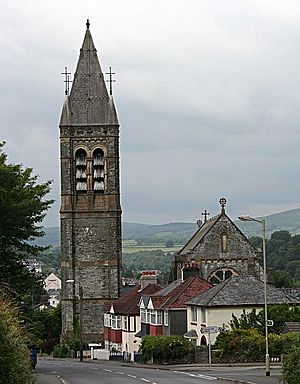Tavistock facts for kids
Quick facts for kids Tavistock |
|
|---|---|
| Stannary Town | |
 Tavistock town centre |
|
 Coat of arms |
|
| Population | 12,675 (2021 census) |
| OS grid reference | SX480740 |
| District |
|
| Shire county | |
| Region | |
| Country | England |
| Sovereign state | United Kingdom |
| Post town | TAVISTOCK |
| Postcode district | PL19 |
| Dialling code | 01822 |
| Police | Devon and Cornwall |
| Fire | Devon and Somerset |
| Ambulance | South Western |
| EU Parliament | South West England |
| UK Parliament |
|
Tavistock is an old market town in West Devon, England. It sits on the River Tavy, which is where its name comes from. In 2011, about 13,028 people lived here. The town's story goes back to at least 961. That's when Tavistock Abbey, whose old buildings are still in the town centre, was started. One of the most famous people from Tavistock is Sir Francis Drake.
Contents
Tavistock's Past: A Journey Through Time
Early History and the Abbey
The area around Tavistock has been lived in for a very long time. People were here even before written records began. You can find old remains from the Bronze Age and Iron Age nearby. The River Tavy here was wide and shallow, making it easy to cross.
A special church, called an abbey, was founded in 961. It was dedicated to Saint Mary and Saint Rumon. In 997, Danish raiders attacked and destroyed it. But it was rebuilt and became very rich. One famous leader of the abbey was Aldred. He crowned two kings, Harold II and William I.
Markets and Fairs Begin
In 1105, King Henry I gave the monks of Tavistock a special permission. This allowed them to hold a weekly "Pannier Market" on Fridays. "Pannier" means a basket used to carry goods. This market still happens today!
In 1116, they also got permission for a three-day fair. This fair celebrated Saint Rumon. This tradition continues today as the annual "Goosey" fair. It takes place on the second Wednesday in October.
By 1185, Tavistock became a borough, which is a town with its own government. In 1295, it could send two people to represent it in parliament. The abbey church was rebuilt in 1285.
Tavistock became important for tin mining. In 1305, it was named one of four "stannary towns." This meant tin was weighed and stamped here. Special courts were held to manage mining.
The Parish Church
The St Eustachius' Church was first dedicated in 1318. It was rebuilt and made bigger between 1350 and 1450. A special part, the Clothworkers' Aisle, was added. This shows how important the textile industry was to the town.
The church has a tall tower. Inside, you can see beautiful stained glass windows. One window was made by William Morris. You might also spot a special carving called a 'Tinners' Hares'. This shows three rabbits or hares sharing three ears.
The Russell Family and New Industries
The abbey was largely rebuilt in 1457–1458. Tavistock continued to do well under the abbots. It even got one of England's first printing presses in 1525.
However, in 1539, the abbey was torn down during the dissolution of the monasteries. After this, the powerful Russell family took over much of the land. They became the Earls and later Dukes of Bedford.
In the 17th century, a lot of cloth was sold at the Friday market. Tavistock was also known for its copper, manganese, lead, silver, and tin mines. The town also traded in cattle and corn.
The Russell family's connection to Tavistock was so strong that the eldest son of the Duke of Bedford is called the Marquess of Tavistock. This shows how important the town and its minerals were to their wealth.
Sir Francis Drake: A Local Hero
Around 1540, Sir Francis Drake was born near Tavistock. He became a very famous person. He was a champion for Queen Elizabeth. He was the first Englishman to sail all the way around the world between 1577 and 1580. He also helped lead the English to victory against the Spanish Armada in 1588.
A famous statue of Drake in Plymouth is a copy of one in Tavistock. Drake later lived at Buckland Abbey, which is now a museum about him.
English Civil War
During the English Civil War (starting in 1642), Tavistock was first held by the Parliamentarians. Later, King Charles I and his Royalist soldiers stayed there in 1643. The Parliamentarian army took the town back in 1646.
Modern Tavistock: Changes and Growth
By 1800, tin mining and cloth making were not as strong. But copper mining became very important. In 1817, the Tavistock Canal was dug. This canal helped carry copper to Morwellham Quay on the River Tamar. From there, it could be loaded onto ships.
In the mid-19th century, Tavistock was booming again because of copper mining. The 7th Duke of Bedford earned a huge amount of money from it. He built a large reservoir to supply water to the town in 1845. He also built many houses for miners.
The Duke of Bedford also changed the town centre. He built the current Tavistock Town Hall and the Pannier Market buildings. The railway arrived in 1859. This connected Tavistock to other major lines.
Schools and Community
Kelly College, a private school, opened in 1877. It was for the children of Admiral Benedictus Marwood Kelly and orphan sons of naval officers. It later joined with Mount House to become Mount Kelly Foundation.
In 1911, the Bedford family sold most of their land in Tavistock. This ended their influence after more than 450 years.
West Devon Borough Council, which manages the local area, is based in Tavistock. The town also has a war memorial in Bedford Square. It remembers the people from Tavistock who died in the First and Second World Wars.
World War II and Beyond
In May 1943, parts of the American 29th Infantry division stayed in Tavistock. Important leaders like Dwight D. Eisenhower visited them. These soldiers later left Tavistock in May 1944 to be part of the Omaha Beach landings.
Tavistock used to have two railway stations, but both are now closed. The main station building of Tavistock North is now a bed and breakfast. The old railway track is now a public footpath and nature reserve. You can walk across the viaducts that look over the town. There are talks about possibly reopening a train link to Plymouth.
In 1986, the town's two newspapers joined to form the Tavistock Times Gazette. In 2007, the newspaper celebrated 150 years with a visit from the Prince of Wales and Duchess of Cornwall.
In 2006, Tavistock became the eastern Gateway to the Cornish Mining World Heritage Site. This means it's part of a special area recognized globally for its history.
Tavistock's Location and Surroundings
Tavistock is on the edge of Dartmoor, about 24 kilometers (15 miles) north of Plymouth. The town's centre is Bedford Square. Here you'll find St. Eustachius' Church, the old abbey ruins, the town hall, and the Pannier Market.
The A386 road, called Plymouth Road, has many hotels and bed and breakfast places. It's also where the town's bus station is. Between Plymouth Road and the River Tavy is a park called the Meadows. It has car parks, a theatre, a cinema, and a public swimming pool.
To the north and east of town is Whitchurch Down, where Dartmoor begins.
Weather in Tavistock
Tavistock has an oceanic climate, which means it has mild temperatures.
| Climate data for Tavistock | |||||||||||||
|---|---|---|---|---|---|---|---|---|---|---|---|---|---|
| Month | Jan | Feb | Mar | Apr | May | Jun | Jul | Aug | Sep | Oct | Nov | Dec | Year |
| Mean daily maximum °C (°F) | 8 (46) |
8 (46) |
9 (48) |
12 (54) |
14 (57) |
17 (63) |
19 (66) |
19 (66) |
17 (63) |
14 (57) |
11 (52) |
9 (48) |
13 (55) |
| Mean daily minimum °C (°F) | 3 (37) |
3 (37) |
4 (39) |
5 (41) |
8 (46) |
11 (52) |
13 (55) |
13 (55) |
11 (52) |
9 (48) |
6 (43) |
4 (39) |
8 (46) |
| Source: Weather Channel | |||||||||||||
Places of Worship
- See also Tavistock Abbey
- For the parish church of St Eustachius, see above, Parish church
- The Roman Catholic Church of Our Lady of the Assumption and St Mary Magdalene was built in 1867. It has a tall spire that you can see from far away. This church was meant for miners to worship. It was later bought in 1952 to be a Roman Catholic church.
Education in Tavistock
Public Schools
Most older students go to Tavistock College. This is a state-funded school with about 2,000 students. It has special links with countries like Japan, Uganda, Spain, and India. Some students travel to grammar schools in Plymouth.
Tavistock has several primary schools. These include St Peter's (a Church of England school), St Rumon's, Tavistock Community Primary, and Whitchurch Primary.
Private Schools
Mount Kelly School is the private school in Tavistock. It has two main sites for different age groups. The school has 570 students from ages 3 to 18. Mount Kelly was formed in 2014 when two schools, Kelly College and Mount House School, joined together.
Life and Events in Tavistock
Shopping and Markets
Tavistock is still a small market town. It offers shopping and fun for its residents, nearby villages, and farmers. It's also a hub for tourists visiting West Devon and Dartmoor. Many people who work in Plymouth live here.
The main market is in the large covered building called the Pannier Market. It was finished in 1860. The main market day is Friday. On other days, it hosts special events like craft fairs and antiques fairs. A Farmers' Market happens every two weeks in the Square. It has been named the Best Farmer's Market in the South West.
In 2005, Tavistock was voted 'Best Market Town' in England. In 2006, it was named 'Best Food Town'. This is because of its many independent food shops. The town also became Devon's second Fairtrade Town in 2006.
Fun Events
The biggest event in Tavistock is the annual Tavistock Goose Fair. Locals call it the "Goosey Fair". It has been happening since 1116! It takes over much of the town on the second Wednesday of October. Many people visit, far more than live in the town.
Traditionally, people bought geese for Christmas at the fair. Today, it has many rides and games, like those at a funfair.
Other events include a two-day garden festival in May. There's also a carnival with a two-day Balloon Fiesta in August. In May, there is an annual Tavistock Music & Arts Festival.
In 2010, the town was a starting point for a stage of the 2010 Tour of Britain cycle race.
On the first Sunday in October, the annual Abbots Way Walk finishes in Tavistock. This challenging walk starts at Buckfast Abbey. Participants walk 24 miles across Southern Dartmoor to finish in Tavistock.
Getting Around Tavistock
Buses
The main bus company in Tavistock is Stagecoach South West. They run routes to Plymouth and Bere Alston. There's also a local town service. Plymouth Citybus runs services to Dartmoor.
Trains
The closest train stations are at:
- Okehampton for trains to Exeter St Davids.
- Plymouth for trains to many cities like Bristol, Cardiff, and London.
Tavistock used to have two train stations, but they both closed in the 1960s. There are plans to open a new station. This would connect Tavistock to Plymouth again.
Roads
The A386 road links Tavistock to the A30 in the north and the A380 in the south.
Culture and Sports
Tavistock has its own special coat of arms. It shows a fleece, which stands for the wool trade. The town's motto is "Crescit sub pondere virtus," meaning "virtue flourishes under a burden."
Tavistock Penny Token
There's a special coin called the Tavistock Penny Token. It's a copy of an old coin from 1811. It's made of copper to celebrate the town's mining history. One side has the Tavistock fleur-de-lys. The other side shows a carving of a mine.
Books and Stories
The poet William Browne was born in Tavistock. The town is also mentioned in some of Arthur Conan Doyle's Sherlock Holmes stories. These include The Hound of the Baskervilles. It also appears in Lorna Doone by R. D. Blackmore.
Sports Teams
Tavistock has one main football team, Tavistock A.F.C.. There are also two junior teams, Tavistock Town and Tavistock Thistles. Together, they form Tavistock Community Football Club. This club offers coaching and games for all ages, from 5 years old to adults. There is also a rugby team, Tavistock Rugby Football Club.
Local Media
Local TV news for Tavistock comes from BBC South West and ITV West Country.
Tavistock's local radio stations are BBC Radio Devon (103.4 FM), Heart West (96.6 FM), and Greatest Hits Radio South West (105.5 FM).
The Tavistock Times Gazette is the town's local newspaper. It comes out every Thursday.
Town Twinning

Tavistock has special "twinning" links with two other towns:
- Pontivy in France (since 1958)
- Celle in Germany
Famous People from Tavistock
- Mary Colling, a poet.
- Sir Francis Drake, who was born nearby and was mayor of Tavistock.
- Rosie Huntington-Whiteley, a model, grew up on a farm near Tavistock.
- Pete Quaife, the bass player for The Kinks, was born here.
- Olympians Kate Allenby and Heather Fell have connections to Tavistock.
- Graham Dawe (England rugby player) and Rob Baxter (Exeter Chiefs rugby coach) were both born in Tavistock.
- The hymn writer Elizabeth Parsons was also born in the town.
Images for kids
See also
 In Spanish: Tavistock para niños
In Spanish: Tavistock para niños







